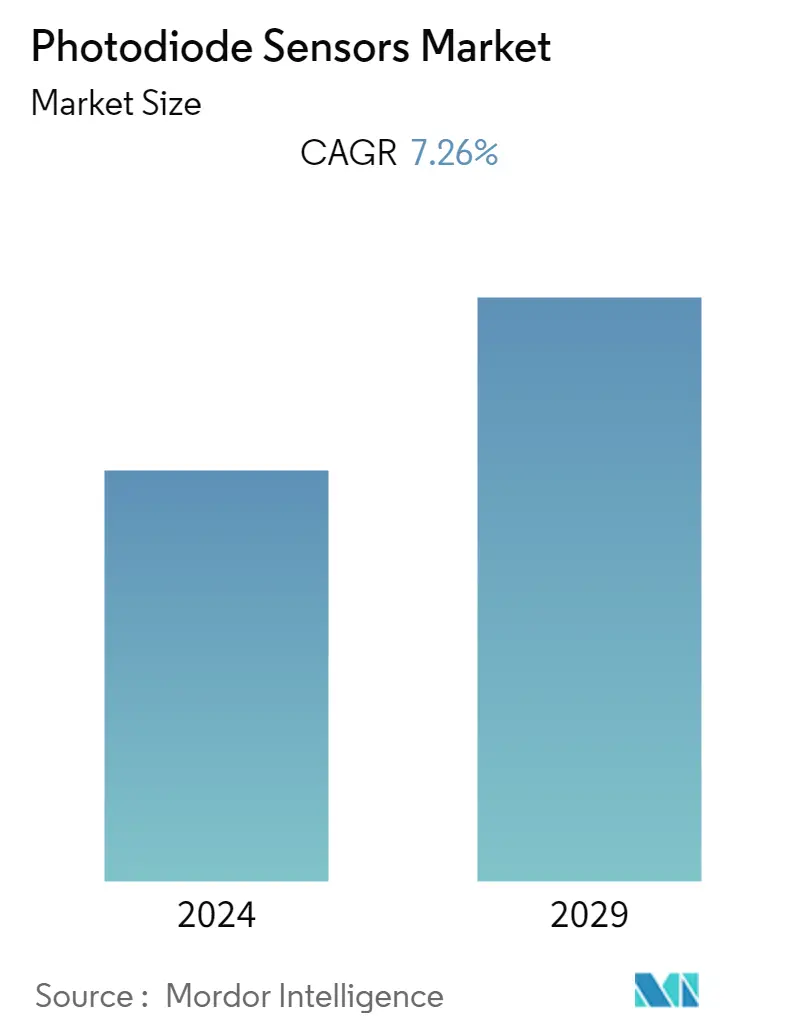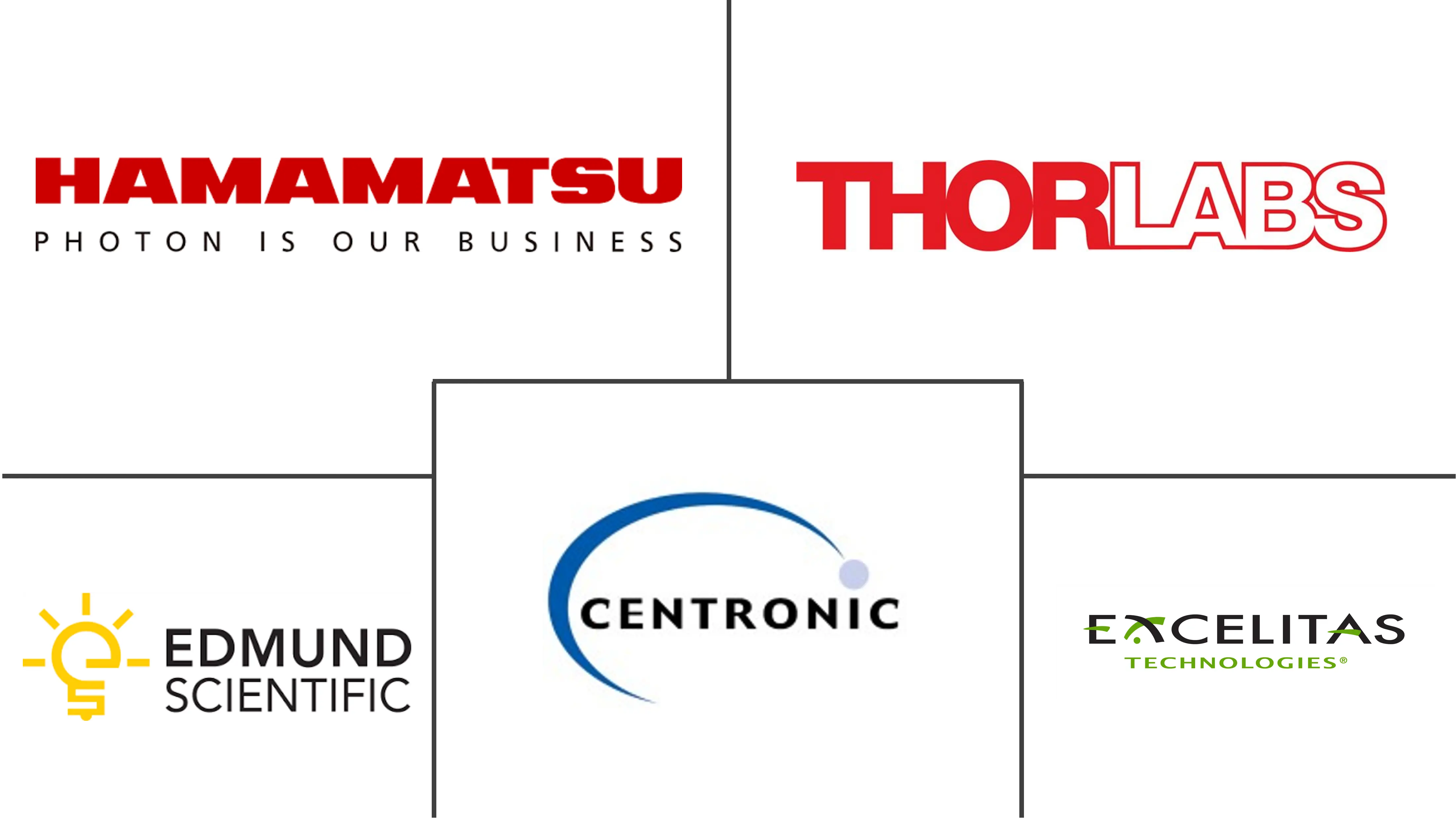Market Size of Photodiode Sensors Industry

| Study Period | 2019 - 2029 |
| Base Year For Estimation | 2023 |
| CAGR | 7.26 % |
| Fastest Growing Market | Asia-Pacific |
| Largest Market | North America |
| Market Concentration | Medium |
Major Players
*Disclaimer: Major Players sorted in no particular order |
Photodiode Sensors Market Analysis
The photodiode sensors market is expected to grow at a CAGR of 7.26% in the forecast period. Due to the growing reliance of medical instruments on photodiode sensors for use in pulse oximetry, spectroscopic analysis, and medical imaging, the market for photodiode sensors worldwide is experiencing significant advancements. Additionally, the market expansion of photodiodes is fueled by the rising use of electronic systems in the automotive and consumer electronics industries.
- Photodiode sensors have a few special characteristics that make them stand out, including integrated functionality, improved performance, high reliability, and rapid response times. Therefore, the growing use of light/optical sensors in medical devices, aerospace & defense, and consumer electronics is expected to be a highly lucrative segment during the forecast period, contributing to the growth of the global photodiode sensor market.
- Moreover, the market for photodiodes will also be boosted by Wearable Health Devices, which include fitness trackers and smartwatches and are used for various applications including blood oxygen concentration, optical heart rate detection and health monitoring. Photodiodes are also used in devices for monitoring blood pressure, body temperature, etc. which will likely fuel further market expansion.
- Barcode scanning is another use for photodiodes, which helps organizations track a lot of data and is employed to boost productivity and efficiency in a variety of industries. Another important factor driving the expansion of the photodiode sensor market is the growing awareness of the quick processing times for billing and purchase transactions as well as improvements in the impact of the customer experience in retail stores. These developments are also driving an increase in the demand for barcode scanners across the retail sector.
- Additionally, The development of new optical detectors will increase the demand for photodiodes, as will the use of photodiodes by smartphone cameras and proximity sensors to identify objects or focus on them. These developments in semiconductor technology and the emergence of new applications (optical communication, optical sensing, etc.) drive this demand. These factors will encourage market growth.
- However, one of the main obstacles to the growth of the global photodiode sensor market is the temperature dependence of photodiodes. Every photodiode has a temperature dependence that affects its dark current, shunt resistance, sensitivity, and breakdown voltage when the temperature changes. This also affects other factors, such as junction capacitance, which negatively affects a photodiode's general performance characteristics.
- The demand for photodiode sensor has been rising quickly as the global economies recover from the COVID-19 pandemic. This quick increase in demand has been witnessed especially in the personal medical devices segments as the pandemic has significantly enhanced the health conciousness of the people. Hence, the increased use of sensors spurs new developments and aids the vendors further expand their market presence.
Photodiode Sensors Industry Segmentation
Photodiode sensors are light-sensing devices that convert light energy into electrical energy. Photodiodes produce an electric current by using light energy as an input. Photodiodes are semi-conducting components with PN junctions, also referred to as light detectors, photosensors, or photodetectors.
The study tracks the sales of Photodiode Sensors in the Global Market. Both Monolithic and assembled modules that detect the presence of light and change it into electrical voltages or currents - discrete and combo sensors such as Ambient Light Sensors (ALS), Proximity Sensors, Color Sensors, etc. are tracked as a part of the study. The photodiode sensors market is segmented into sensor types (PN Photodiode Sensors, PIN Photodiode Sensors, Avalanche Photodiode Sensors, Schottky Photodiode Sensors), By End-User Industry (Consumer Electronics, Telecommunications, Aerospace & Defense, Healthcare, Automotive, and Industrial), and By Geography. Additionally, the impact analysis of COVID-19 is also part of the study. The market sizes and forecasts are provided in terms of value (USD million) for all the above segments.
| By Sensor Type | |
| PN Photodiode Sensors | |
| PIN Photodiode Sensors | |
| Avalanche Photodiode Sensors | |
| Schottky Photodiode Sensors |
| By End User Industry | |
| Consumer Electronics | |
| Telecommunications | |
| Aerospace and Defense | |
| Healthcare | |
| Automotive | |
| Industrial | |
| Other End-user Industries |
| By Geography | |
| Americas | |
| Europe | |
| China | |
| Japan | |
| Rest of the World |
Photodiode Sensors Market Size Summary
The photodiode sensors market is poised for substantial growth, driven by their increasing integration into medical instruments, automotive, and consumer electronics. These sensors are essential in applications such as pulse oximetry, spectroscopic analysis, and medical imaging, highlighting their critical role in advancing medical technology. The market's expansion is further supported by the rising adoption of electronic systems across various sectors, including aerospace and defense. Photodiode sensors are characterized by their integrated functionality, high reliability, and rapid response times, making them highly desirable in diverse applications. The burgeoning demand for wearable health devices, such as fitness trackers and smartwatches, also contributes to market growth, as these devices rely on photodiodes for health monitoring functions. Additionally, the use of photodiodes in barcode scanning enhances productivity and efficiency across industries, particularly in retail, where quick processing times and improved customer experiences are paramount.
The Asia Pacific region is anticipated to lead the photodiode sensors market, fueled by its robust consumer electronics, automotive, and telecommunications industries. Countries like China, South Korea, and Japan are at the forefront, with China's significant consumer electronics exports bolstering its market position. The region's diverse industries, including mining, food processing, and textiles, further drive demand for photodiode sensors, particularly for applications involving laser devices and optical scanners. The automotive industry's focus on meeting international standards and driving innovations in photodiode technology also supports market growth. The market is characterized by fragmentation, with numerous global players engaging in continuous innovation to capture market share. Recent advancements, such as Vishay Intertechnology's energy-efficient electronic components and OSI Optoelectronics' dual-sandwich detectors, exemplify the ongoing technological developments shaping the market landscape.
Photodiode Sensors Market Size - Table of Contents
-
1. MARKET INSIGHTS
-
1.1 Market Overview
-
1.2 Industry Attractiveness -Porter's Five Forces Analysis
-
1.2.1 Threat of New Entrants
-
1.2.2 Bargaining Power of Buyers/Consumers
-
1.2.3 Bargaining Power of Suppliers
-
1.2.4 Threat of Substitute Products
-
1.2.5 Intensity of Competitive Rivalry
-
-
1.3 Impact of COVID-19 on the Market
-
1.4 Technology Snapshot (Silicon, Germanium, Indium Gallium Arsenide Phosphide (InGaAsP), Indium Gallium Arsenide (InGaAs))
-
-
2. MARKET SEGMENTATION
-
2.1 By Sensor Type
-
2.1.1 PN Photodiode Sensors
-
2.1.2 PIN Photodiode Sensors
-
2.1.3 Avalanche Photodiode Sensors
-
2.1.4 Schottky Photodiode Sensors
-
-
2.2 By End User Industry
-
2.2.1 Consumer Electronics
-
2.2.2 Telecommunications
-
2.2.3 Aerospace and Defense
-
2.2.4 Healthcare
-
2.2.5 Automotive
-
2.2.6 Industrial
-
2.2.7 Other End-user Industries
-
-
2.3 By Geography
-
2.3.1 Americas
-
2.3.2 Europe
-
2.3.3 China
-
2.3.4 Japan
-
2.3.5 Rest of the World
-
-
Photodiode Sensors Market Size FAQs
What is the current Photodiode Sensors Market size?
The Photodiode Sensors Market is projected to register a CAGR of 7.26% during the forecast period (2024-2029)
Who are the key players in Photodiode Sensors Market?
Hamamatsu Photonics K.K, Thorlabs, Inc., Edmund Scientific Corporation (Edmund Optics), Centronic, Ltd. and Excelitas Technologies Corporation are the major companies operating in the Photodiode Sensors Market.

